Child Injury Risk from Car Accidents May Be Reduced
Earlier this month, the U.S. Centers for Disease Control and Prevention (CDC) issued a new report that highlights the importance of more public education on the risks of children riding in cars unrestrained or improperly restrained, indicating that implementation strategies may greatly reduce the risk of children suffering a car accident injury.
 One of the biggest indicators about whether a child is restrained in a car is whether adults themselves use a seatbelt, with 41.3% of parents who do not use a seatbelt allowing their child to ride unrestrained.
One of the biggest indicators about whether a child is restrained in a car is whether adults themselves use a seatbelt, with 41.3% of parents who do not use a seatbelt allowing their child to ride unrestrained.
In sharp contrast, only 2.2% of parents who use seat belts report ever allowing their children to not be properly restrained in a car.
Data on car accidents, medical outcomes and hospital charges among children under the age of 12 was the focus of a surveillance summary published in the CDC’s Morbidity and Mortality Weekly Report on October 2.
According to the CDC, car accidents are a leading cause of death among children, with 638 children ages 12 and under killed in 2013, and about 127,266 children injured in car accidents. Among the deaths, 38% of those children were unrestrained at the time of the crash.
Among those children non-fatally injured in car accidents, the CDC indicates that there is little reliable data on the use of restraints. However, from what information was available, the researchers indicate that children who were restrained properly were much less likely to suffer neck, abdominal, or head injuries, particularly traumatic brain injuries.
Proper car seat, booster seat, and seat belt use among children in the back seat prevents injuries and deaths, as well as averts hospital charges. However, the number, severity, and cost of injuries among children in crashes who were not optimally restrained or who were seated in a front seat indicates the need for improvements in proper use of age- and size-appropriate car seats, booster seats, and seat belts in the back seat.”
The CDC indicates that it is well known and established that strategies are needed to prevent injuries and deaths among child passengers in car accidents, however the efforts are not universally implemented. More even implementation, and thus more use of proper child restraints, would help reduce child deaths and injuries the report found.


No Comments • Add Your Comments